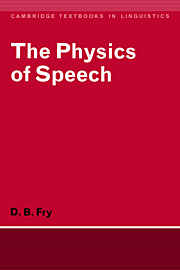Book contents
- Frontmatter
- Contents
- List of phonetic symbols
- 1 The speech chain
- 2 The generation of sound
- 3 The propagation of sound waves
- 4 Absorption and reflection of sound energy
- 5 Free and forced vibrations: resonance
- 6 The speech mechanism as sound generator
- 7 The vocal tract
- 8 Periodic and aperiodic sounds
- 9 Acoustic analysis: the sound spectrograph
- 10 Acoustic features of English sounds
- 11 Acoustic cues for the recognition of speech sounds
- Index
5 - Free and forced vibrations: resonance
Published online by Cambridge University Press: 05 June 2012
- Frontmatter
- Contents
- List of phonetic symbols
- 1 The speech chain
- 2 The generation of sound
- 3 The propagation of sound waves
- 4 Absorption and reflection of sound energy
- 5 Free and forced vibrations: resonance
- 6 The speech mechanism as sound generator
- 7 The vocal tract
- 8 Periodic and aperiodic sounds
- 9 Acoustic analysis: the sound spectrograph
- 10 Acoustic features of English sounds
- 11 Acoustic cues for the recognition of speech sounds
- Index
Summary
Up to this point we have concerned ourselves only with sounds which result from applying a force to some vibrating system and then removing the source of energy, leaving the system as it were to its own devices. This is the situation when we strike the tuning fork or hit the table top, pluck a string or strike a piano key; we supply force once and the system emits a sound whose characteristics are determined by its own properties. It may last for a long time, as it does in the case of the tuning fork, or die almost immediately, as in the case of the table top; it may be the result of many modes of vibration, as in the plucked string and the piano, or of a single mode, as in the tuning fork, and this means that it is either a complex tone consisting of a fundamental frequency and an extended range of harmonics or a pure tone. All wave-motions that are produced in this way, by applying a force for a very brief time and then removing it, are the result of free vibrations. A system which is performing free vibrations will be oscillating at its natural frequency, and this term refers to the fundamental frequency, since any harmonics that are generated will be tied to this frequency.
In the generation of sound waves there are, however, other possibilities which another familiar example will help to make clear.
- Type
- Chapter
- Information
- The Physics of Speech , pp. 49 - 60Publisher: Cambridge University PressPrint publication year: 1979

